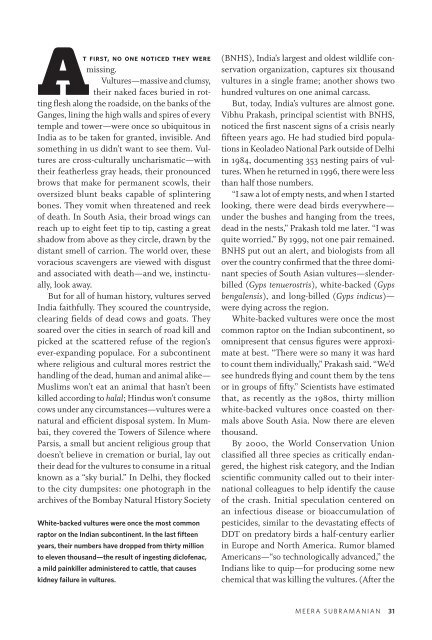You also want an ePaper? Increase the reach of your titles
YUMPU automatically turns print PDFs into web optimized ePapers that Google loves.
At first, no one noticed they were<br />
missing.<br />
<strong>Vultures</strong>—massive and clumsy,<br />
their naked faces buried in rotting<br />
flesh along the roadside, on the banks of the<br />
Ganges, lining the high walls and spires of every<br />
temple and tower—were once so ubiquitous in<br />
India as to be taken for granted, invisible. And<br />
something in us didn’t want to see them. <strong>Vultures</strong><br />
are cross-culturally uncharismatic—with<br />
their featherless gray heads, their pronounced<br />
brows that make for permanent scowls, their<br />
oversized blunt beaks capable of splintering<br />
bones. They vomit when threatened and reek<br />
of death. In South Asia, their broad wings can<br />
reach up to eight feet tip to tip, casting a great<br />
shadow from above as they circle, drawn by the<br />
distant smell of carrion. The world over, these<br />
voracious scavengers are viewed with disgust<br />
and associated with death—and we, instinctually,<br />
look away.<br />
But for all of human history, vultures served<br />
India faithfully. They scoured the countryside,<br />
clearing fields of dead cows and goats. They<br />
soared over the cities in search of road kill and<br />
picked at the scattered refuse of the region’s<br />
ever-expanding populace. For a subcontinent<br />
where religious and cultural mores restrict the<br />
handling of the dead, human and animal alike—<br />
Muslims won’t eat an animal that hasn’t been<br />
killed according to halal; Hindus won’t consume<br />
cows under any circumstances—vultures were a<br />
natural and efficient disposal system. In Mumbai,<br />
they covered the Towers of Silence where<br />
Parsis, a small but ancient religious group that<br />
doesn’t believe in cremation or burial, lay out<br />
their dead for the vultures to consume in a ritual<br />
known as a “sky burial.” In Delhi, they flocked<br />
to the city dumpsites: one photograph in the<br />
archives of the Bombay Natural History Society<br />
White-backed vultures were once the most common<br />
raptor on the Indian subcontinent. In the last fifteen<br />
years, their numbers have dropped from thirty million<br />
to eleven thousand—the result of ingesting diclofenac,<br />
a mild painkiller administered to cattle, that causes<br />
kidney failure in vultures.<br />
(BNHS), <strong>India’s</strong> largest and oldest wildlife conservation<br />
organization, captures six thousand<br />
vultures in a single frame; another shows two<br />
hundred vultures on one animal carcass.<br />
But, today, <strong>India’s</strong> vultures are almost gone.<br />
Vibhu Prakash, principal scientist with BNHS,<br />
noticed the first nascent signs of a crisis nearly<br />
fifteen years ago. He had studied bird populations<br />
in Keoladeo National Park outside of Delhi<br />
in 1984, documenting 353 nesting pairs of vultures.<br />
When he returned in 1996, there were less<br />
than half those numbers.<br />
“I saw a lot of empty nests, and when I started<br />
looking, there were dead birds everywhere—<br />
under the bushes and hanging from the trees,<br />
dead in the nests,” Prakash told me later. “I was<br />
quite worried.” By 1999, not one pair remained.<br />
BNHS put out an alert, and biologists from all<br />
over the country confirmed that the three dominant<br />
species of South Asian vultures—slenderbilled<br />
(Gyps tenuerostris), white-backed (Gyps<br />
bengalensis), and long-billed (Gyps indicus)—<br />
were dying across the region.<br />
White-backed vultures were once the most<br />
common raptor on the Indian subcontinent, so<br />
omnipresent that census figures were approximate<br />
at best. “There were so many it was hard<br />
to count them individually,” Prakash said. “We’d<br />
see hundreds flying and count them by the tens<br />
or in groups of fifty.” Scientists have estimated<br />
that, as recently as the 1980s, thirty million<br />
white-backed vultures once coasted on thermals<br />
above South Asia. Now there are eleven<br />
thousand.<br />
By 2000, the World Conservation Union<br />
classified all three species as critically endangered,<br />
the highest risk category, and the Indian<br />
scientific community called out to their international<br />
colleagues to help identify the cause<br />
of the crash. Initial speculation centered on<br />
an infectious disease or bioaccumulation of<br />
pesticides, similar to the devastating effects of<br />
DDT on predatory birds a half-century earlier<br />
in Europe and North America. Rumor blamed<br />
Americans—“so technologically advanced,” the<br />
Indians like to quip—for producing some new<br />
chemical that was killing the vultures. (After the<br />
meera SuBramanIan 31












